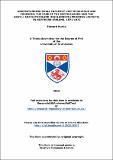Files in this item
Understanding small infantry unit behaviour and cohesion : the case of the Scots Guards and the Argyll and Sutherland Highlanders (Princess Louise’s) in Northern Ireland, 1971-1972
Item metadata
| dc.contributor.advisor | English, Richard | |
| dc.contributor.author | Burke, Edward | |
| dc.coverage.spatial | 368 p. | en_US |
| dc.date.accessioned | 2016-03-29T14:18:21Z | |
| dc.date.available | 2016-03-29T14:18:21Z | |
| dc.date.issued | 2016-06-21 | |
| dc.identifier | uk.bl.ethos.682788 | |
| dc.identifier.uri | https://hdl.handle.net/10023/8507 | |
| dc.description.abstract | This is the first such study of Operation Banner: taking three Battalions as case studies, drawing upon extensive interviews with former soldiers, primary archival sources including unpublished diaries, this thesis closely examines soldiers’ behaviour at the small infantry-unit level (Battalion downwards), including the leadership, cohesion, orientation and motivation that sustained, restrained and occasionally obstructed soldiers in Northern Ireland. It contends that there are aspects of wider scholarly literatures - from sociology, anthropology, criminology, and psychology - that can throw new light on our understanding of the British Army in Northern Ireland. The thesis will also contribute fresh insights and analysis of important events during the early years of Operation Banner, including the murders of two men in County Fermanagh, Michael Naan and Andrew Murray, and that of Warrenpoint hotel owner Edmund Woolsey in South Armagh in the autumn of 1972. The central argument of this thesis is that British Army small infantry units enjoyed considerable autonomy during the early years of Operation Banner and could behave in a vengeful, highly aggressive or benign and conciliatory way as their local commanders saw fit. The strain of civil-military relations at a senior level was replicated operationally – as soldiers came to resent the limitations of waging war in the UK. The unwillingness of the Army’s senior leadership to thoroughly investigate and punish serious transgressions of standard operating procedures in Northern Ireland created uncertainty among soldiers over expected behaviour and desired outcomes. Mid-ranking officers and NCOs often played important roles in restraining soldiers in Northern Ireland. The degree of violence used in Northern was much less that that seen in the colonial wars fought since the end of World War II. But overly aggressive groups of soldiers could also be mistaken for high-functioning units – with negative consequences for the Army’s overall strategy in Northern Ireland. | en |
| dc.language.iso | en | en_US |
| dc.publisher | University of St Andrews | |
| dc.rights | Creative Commons Attribution-NonCommercial-NoDerivatives 4.0 International | |
| dc.rights.uri | http://creativecommons.org/licenses/by-nc-nd/4.0/ | |
| dc.subject | Irish history | en_US |
| dc.subject | Sociology | en_US |
| dc.subject | Strategic studies | en_US |
| dc.subject | Military | en_US |
| dc.subject | British history | en_US |
| dc.subject | Insurgency | en_US |
| dc.subject | Terrorism | en_US |
| dc.subject | Conflict | en_US |
| dc.subject.lcc | UA652.S3B8 | |
| dc.subject.lcc | UA652.A8 | |
| dc.subject.lcsh | Great Britain. Army. Scots Guards | en_UK |
| dc.subject.lcsh | Great Britain. Army. Argyll and Sutherland Highlanders | en_UK |
| dc.subject.lcsh | Northern Ireland--History--1969-1994 | en_UK |
| dc.subject.lcsh | Infantry--History--20th century | en_UK |
| dc.title | Understanding small infantry unit behaviour and cohesion : the case of the Scots Guards and the Argyll and Sutherland Highlanders (Princess Louise’s) in Northern Ireland, 1971-1972 | en_US |
| dc.type | Thesis | en_US |
| dc.type.qualificationlevel | Doctoral | en_US |
| dc.type.qualificationname | PhD Doctor of Philosophy | en_US |
| dc.publisher.institution | The University of St Andrews | en_US |
This item appears in the following Collection(s)
Except where otherwise noted within the work, this item's licence for re-use is described as Creative Commons Attribution-NonCommercial-NoDerivatives 4.0 International
Items in the St Andrews Research Repository are protected by copyright, with all rights reserved, unless otherwise indicated.


